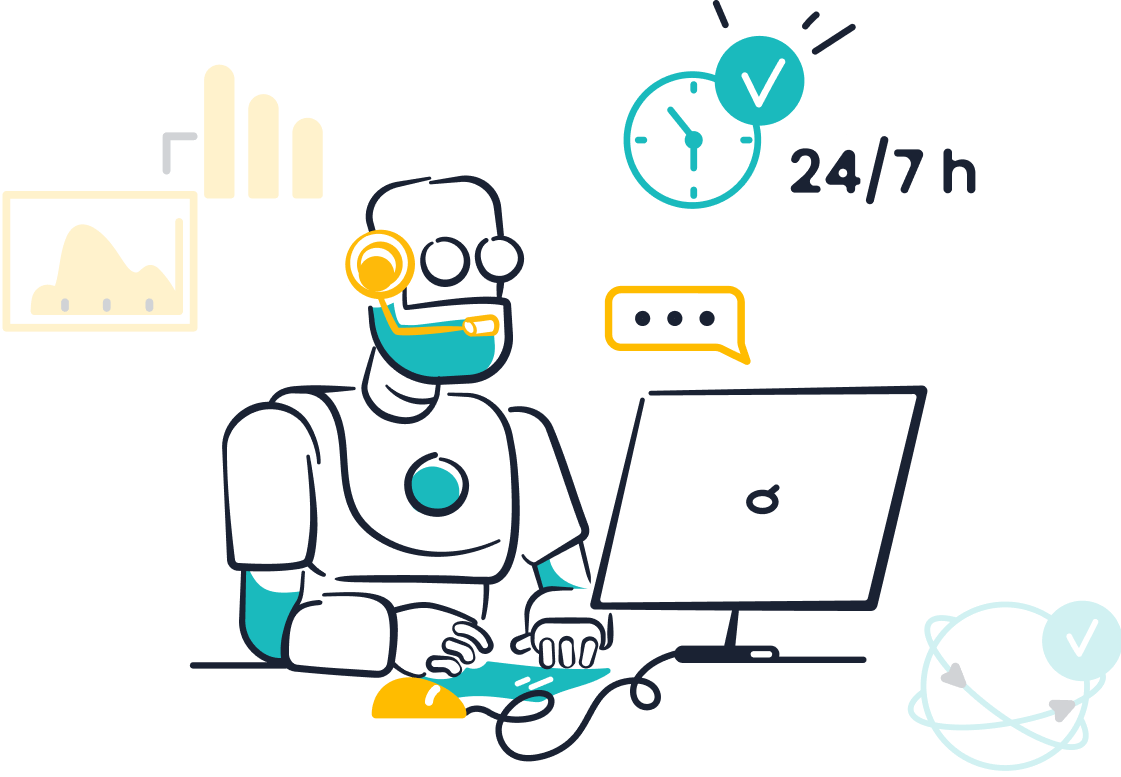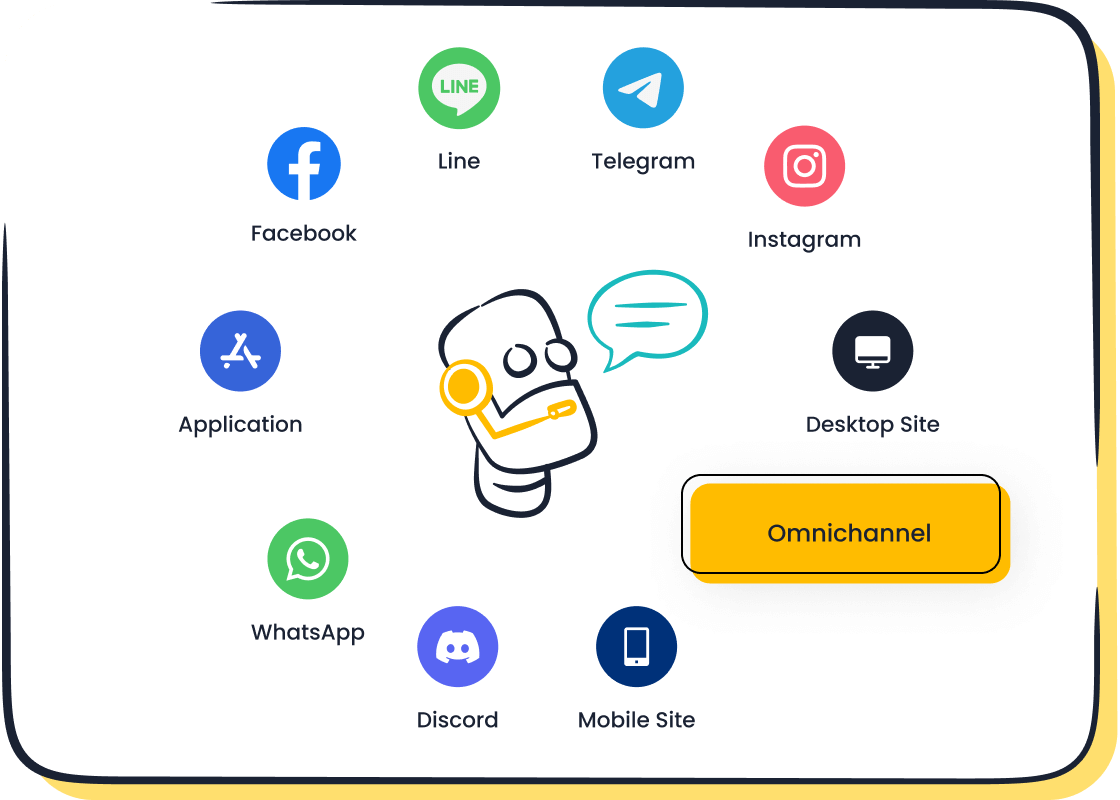What automated customer service means for businesses today

Automate customer service uses technology, like AI and automation, to handle customer interactions without human intervention. It’s transforming how businesses engage with customers by improving efficiency and satisfaction. For instance, 65% of businesses plan to increase their use of AI in customer experience this year. Self-service systems are gaining popularity as customers prefer resolving issues independently, reducing costs and boosting operational speed. Companies like JPMorgan Chase automated 80% of routine tasks, cutting processing times by 93%, which led to higher customer satisfaction and profitability. Solutions like Sobot ensure businesses stay ahead in this automate customer service revolution.
What is automated customer service?
Definition and core principles
Automated customer service refers to the use of advanced technologies like artificial intelligence (AI) and automation to manage customer interactions with minimal or no human involvement. These systems are designed to handle repetitive tasks, such as answering common questions or routing inquiries, allowing businesses to focus on more complex customer needs. By leveraging AI, automated systems can analyze data, understand customer intent, and provide personalized responses.
Core Principles of Automated Customer Service:
- Efficiency: Handle high volumes of inquiries quickly and accurately.
- Personalization: Use historical data to tailor responses to individual customers.
- Accessibility: Provide 24/7 support across multiple channels.
- Scalability: Adapt to growing customer demands without increasing costs.
For example, automated systems often rely on natural language processing (NLP) to interpret customer queries and machine learning to improve over time. This combination ensures faster response times and higher customer satisfaction. Businesses that adopt these technologies can reduce wait times and prevent customers from seeking alternatives.
Key features of customer service automation
Customer service automation offers several features that enhance both efficiency and customer experience. These features make it a valuable tool for businesses aiming to streamline operations and improve service quality.
- Omnichannel Support: Automated systems integrate with various platforms, such as email, chat, and social media, ensuring seamless communication.
- 24/7 Availability: Customers can access support anytime, reducing frustration and improving satisfaction.
- Self-Service Options: Tools like chatbots and knowledge bases empower customers to resolve issues independently.
- Personalized Interactions: AI analyzes customer data to provide tailored recommendations and solutions.
- Cost Efficiency: Automation reduces the need for additional staff, cutting operational costs significantly.
According to recent studies, 73% of shoppers believe AI improves their customer experience, while 80% of customers report positive interactions with AI-powered tools. These features not only enhance customer satisfaction but also drive business growth by reducing costs and increasing efficiency.
Examples of automated customer service in action
Automated customer service is transforming industries by delivering measurable results. Here are some real-world examples that highlight its impact:
| Metric | Description |
|---|---|
| Average response times | Automated systems drastically reduce the time taken to address inquiries. |
| First contact resolution rates | Many issues are resolved during the first interaction, improving efficiency. |
| Customer satisfaction scores | Businesses report higher satisfaction levels due to faster, accurate support. |
| Net Promoter Score (NPS) | Customers are more likely to recommend services powered by automation. |
| Call abandonment rate | Fewer calls are abandoned as automated systems handle queries promptly. |
For instance, companies like Unity saved $1.3 million by deploying AI agents, while AI automation resolves tickets 52% faster than traditional methods. Additionally, businesses using AI in customer service operations have achieved a 35% cost reduction and a 30% increase in efficiency. These examples demonstrate how automation not only enhances customer experience but also delivers significant financial benefits.
How does automated customer service work?
Role of AI-powered tools like Sobot Chatbot

AI-powered tools, such as Sobot Chatbot, play a pivotal role in transforming customer support. These tools automate routine inquiries, enabling businesses to handle high volumes of customer interactions efficiently. For example, Sobot Chatbot autonomously resolves up to 80% of routine inquiries, reducing the workload on human agents. This allows your team to focus on complex issues that require a personal touch.
Sobot Chatbot also enhances customer engagement by providing faster response times and personalized interactions. Its multilingual capabilities ensure seamless communication with customers worldwide, while its 24/7 availability guarantees support at any time. Businesses using AI-powered chatbots like Sobot have reported up to a 34% increase in customer satisfaction and a 30% reduction in support costs. These tools not only improve operational efficiency but also create a more engaging and satisfying experience for your customers.
Technologies involved: NLP, machine learning, and automation
Automated customer service relies on cutting-edge technologies like natural language processing (NLP), machine learning, and automation. NLP enables systems to understand and respond to customer queries in a conversational manner. For instance, it automates responses to common questions, reducing operational costs and improving efficiency. Machine learning allows these systems to learn from past interactions, refining their accuracy and adaptability over time.
Automation further streamlines processes by handling repetitive tasks, such as routing inquiries or updating customer records. These technologies work together to deliver faster, more accurate support. For example, sentiment analysis powered by NLP tracks customer feedback on social media, helping businesses address complaints proactively. In industries like finance and healthcare, AI-powered chatbots handle routine inquiries, freeing staff to focus on critical tasks.
| Application Area | Description |
|---|---|
| Automating Responses | NLP techniques automate responses to customer queries, enhancing efficiency. |
| Chatbots | Widely used in sectors like finance and education to handle inquiries. |
| Sentiment Analysis | Tracks customer reviews to address complaints proactively. |
| Language Translation | Eliminates linguistic barriers for diverse customer interactions. |
These technologies ensure your customer support system remains efficient, scalable, and responsive to evolving customer needs.
Integration with customer support systems
Seamless integration between automated systems and customer support platforms is essential for delivering a unified experience. Tools like Sobot integrate with various customer support systems, enabling businesses to unify communication channels and access customer data effortlessly. For example, Sobot's omnichannel support connects platforms like WhatsApp, email, and live chat, ensuring consistent interactions across all touchpoints.
Integration also enhances operational efficiency. SAP BTP, for instance, consolidates data from CRM systems, marketing tools, and eCommerce platforms, providing a comprehensive view of customer interactions. This connectivity allows businesses to personalize experiences and improve satisfaction.
| Company Name | Integration Outcome | Annual Savings |
|---|---|---|
| Fayman Group USA | Customized KPI reporting | $50,000 |
| TruBeauty Concepts | Automated eCommerce order workflow | $40,000+ |
| Pajunk | Fully automated EDI processing | 40+ hours/week eliminated |
Sobot's solutions, such as its AI-powered chatbots and ticketing systems, simplify integration by offering customizable interfaces and robust analytics. These features empower your business to optimize workflows, reduce costs, and deliver exceptional customer support.
Benefits of automated customer service for businesses

Cost savings and operational efficiency
Automating customer service significantly reduces operational costs while improving efficiency. By handling multiple queries simultaneously, automated systems eliminate the need for additional staff during peak times. For instance, Deloitte's automation survey reveals that businesses implementing customer service automation report an average cost savings of 32%. Additionally, 43% of contact centers using AI technologies have achieved a 30% reduction in operational costs, according to Statista.
Automation also frees up to 30% of an agent’s time, allowing them to focus on complex customer support tasks. This shift not only enhances productivity but also improves the quality of customer interactions. For example, an insurance company saved $2.1 million annually by automating claims processing, while customer satisfaction ratings soared from 75% to 92% within a quarter.
| Benefit Type | Description |
|---|---|
| Customer Loyalty | Automation fosters loyalty, driving repeat business and higher sales. |
| Cost Reduction | Operational costs decrease as automation handles routine tasks efficiently. |
| Time Savings for Agents | Agents can dedicate more time to resolving complex issues. |
24/7 availability and faster response times
Automated customer service ensures round-the-clock support, meeting customer expectations for instant assistance. Tools like chatbots provide immediate responses to routine inquiries, reducing wait times and improving customer experiences. A McKinsey report highlights that automation boosts productivity by up to 30%, enabling businesses to handle inquiries faster.
| Evidence Description | Impact on Response Times and Availability |
|---|---|
| Automation of initial responses allows for immediate customer engagement. | Improves response times significantly. |
| Chatbots provide 24/7 support, ensuring customers receive assistance anytime. | Enhances availability for customers. |
| Auto-responders can handle initial queries without needing a live representative. | Reduces response time during off-hours. |
By automating customer service, businesses can maintain consistent support across time zones, ensuring no customer feels neglected. This capability enhances customer satisfaction and builds trust.
Enhanced customer satisfaction and scalability
Automating customer service improves customer satisfaction by delivering faster, more accurate responses. It also scales effortlessly to meet growing demands. Businesses using customer service software report higher Net Promoter Scores (NPS) and lower churn rates. For example, firms adopting automation see a 20-25% decrease in operational costs within two years, as noted by the World Economic Forum.
| Key Metrics | Description |
|---|---|
| Customer Satisfaction Score (CSAT) | Measures how satisfied customers are with a product or service. |
| Net Promoter Score (NPS) | Gauges customer loyalty and likelihood of recommending the business to others. |
| Churn Rate | Indicates the percentage of customers who stop using a service over a specific period. |
Self-service help centers, powered by automation, empower customers to resolve issues independently. This approach not only reduces service costs but also enhances customer experiences by providing quick, reliable solutions.
Challenges and limitations of automated customer service
Addressing the lack of human touch
Automating customer service can sometimes lead to a lack of human interaction, which many customers value. While automated systems improve efficiency, they often struggle to replicate empathy and emotional understanding. Studies show that customers prefer human interactions in situations requiring a personal touch, such as resolving complaints or handling sensitive issues. For example, research highlights that robots excel in routine tasks but fall short in service recovery scenarios where empathy is critical.
| Evidence Type | Description |
|---|---|
| Empirical Research | Robots improve efficiency but lack the human interaction customers prefer in service recovery. |
| Customer Preference | Customers favor human interactions in contexts requiring empathy and personal touch. |
| Managerial Insight | Balancing robotic systems with human interaction maintains service quality. |
To address this, businesses can adopt strategies like Interactive Voice Response (IVR) systems, which allow customers to self-route to the right department. Online chat systems also enhance customer experiences by providing quick responses while enabling seamless transitions to human agents for complex issues. Personalization remains key, as 71% of customers prefer interactions tailored to their needs.
Overcoming initial investment and resource challenges
Deploying customer service automation requires significant upfront investment. Businesses must allocate resources for technology acquisition, system integration, and staff training. However, these costs often pay off in the long run. Automation reduces human exposure to hazardous tasks, lowering workplace injuries and associated expenses. For instance, ergonomic challenges cost industries billions annually, but automation mitigates these risks.
- In 2021, workplace injuries cost $167 billion, including medical expenses and lost wages.
- Ergonomic difficulties in manufacturing and services sectors accounted for $45–54 billion annually.
- Automation reduces these costs by minimizing human involvement in repetitive or hazardous tasks.
By planning carefully and leveraging scalable solutions, you can overcome these challenges and achieve long-term benefits.
Ensuring data security and privacy compliance
Automating customer service involves handling large volumes of sensitive customer data. Ensuring data security and privacy compliance is essential to maintain trust. Data Protection Impact Assessments (DPIAs) help businesses identify privacy risks and ensure accountability. Regulations like GDPR mandate these assessments for high-risk data processing activities. AI technologies can automate DPIAs, making risk assessments more efficient and consistent.
The increasing complexity of data processing and frequent data breaches highlight the importance of robust security measures. By implementing encryption, regular audits, and compliance protocols, you can protect customer data and maintain regulatory compliance. These steps not only safeguard your business but also enhance customer trust in your automated systems.
Best practices for implementing automated customer service
Selecting the right tools, such as Sobot's AI solutions
Choosing the right tools is crucial when automating customer service. You should look for solutions that offer multi-channel support, enabling seamless communication across websites, apps, and social media platforms like WhatsApp and Instagram. Tools like Sobot's AI solutions excel in this area, providing omnichannel integration and advanced AI data analysis for customer profiling. These features allow you to tailor service plans to meet specific customer needs.
When evaluating tools, consider their performance benchmarks. For instance, Sobot's solutions deliver a 20% reduction in inbound volume, a 96% positive feedback rate, and an 85% problem resolution rate. These metrics highlight the effectiveness of automated workflows in improving customer satisfaction and operational efficiency.
| Metric | Value |
|---|---|
| Reduction in inbound volume | 20% |
| Positive feedback rate | 96%+ |
| Correct answers rate | 80% |
| Customer satisfaction score | 97% |
| Problem resolution rate | 85% |
| Overall customer happiness | 99% |
By selecting tools with proven results, you can ensure a smoother transition to automation and better outcomes for your business.
Training staff to collaborate with automation
Training your team to work alongside automated systems is essential for success. Start with hands-on training sessions to familiarize employees with platform functionalities. Ongoing coaching and regular one-on-one meetings can help address challenges and improve performance. Aligning individual goals with business objectives ensures everyone works toward the same outcomes.
Incorporating gamification and peer recognition can make training more engaging. For example, rewarding employees for mastering new skills encourages participation and boosts morale. Using performance analytics to track progress helps you identify areas for improvement and provide targeted feedback.
| Training Strategies and Performance Metrics | Description |
|---|---|
| Ongoing coaching | Continuous support for employees to improve performance. |
| Goal alignment | Aligning individual performance goals with larger business objectives. |
| Continuous feedback | Regular feedback to enhance employee performance. |
| Performance analytics | Using data to track and measure progress objectively. |
| SMART goals | Setting Specific, Measurable, Achievable, Relevant, and Time-bound goals. |
| Hands-on training sessions | Practical demonstrations of platform functionality. |
| Regular one-on-one meetings | Facilitating discussions on progress and feedback. |
| Peer recognition and rewards | Encouraging engagement through recognition and rewards. |
| Gamification | Motivating employees to participate in learning and culture-building activities. |
By equipping your staff with the right skills and support, you can create a collaborative environment where automation and human expertise thrive together.
Monitoring performance and gathering customer feedback
Monitoring the performance of automated customer service systems ensures they meet your expectations. Tools like call center monitoring and text analytics software help you evaluate call quality and extract insights from customer interactions. Social media monitoring tools track brand mentions and customer sentiment in real time, allowing you to address issues proactively.
Gathering customer feedback is equally important. Use survey platforms to collect direct feedback and identify pain points. Web analytics tools can provide data on customer behavior, helping you optimize user experiences. For example, analyzing feedback after interactions can reveal areas where your automated workflows need improvement.
- Improved call quality: Monitoring tools track call performance and identify communication issues.
- Enhanced customer satisfaction: Evaluating interactions helps pinpoint strategies to improve retention.
- Customer survey platforms: Collect direct feedback to gauge satisfaction and uncover pain points.
- Social media monitoring tools: Track brand mentions and customer sentiment in real time.
- Web analytics tools: Analyze customer behavior to optimize digital interactions.
By combining performance monitoring with customer feedback, you can continuously refine your automated systems and deliver exceptional service.
Balancing automation with personalization

When to automate versus when to use human support
Knowing when to automate and when to rely on human support is essential for delivering effective customer service. Automation works best for routine tasks like answering FAQs or processing simple transactions. It ensures quick responses and reduces operational costs. However, human support becomes critical in complex situations that require empathy or creative problem-solving. For example, emotionally charged issues or unique customer requests often need a human touch to ensure satisfaction.
Research shows that humans excel in tasks requiring flexibility and nuanced understanding. Automated systems, on the other hand, are ideal for processing large datasets quickly. Combining both approaches allows you to leverage the strengths of each. For instance, AI can handle repetitive inquiries, while human agents focus on building relationships and resolving intricate problems. This balance ensures your customer service remains efficient and empathetic.
| Aspect | Automated Systems | Human Support |
|---|---|---|
| Decision-Making Process | Uses AI algorithms for data processing | Better suited for cognitive and social tasks |
| Flexibility | Limited in unforeseen circumstances | Highly adaptable to unexpected situations |
| Interpretation of Language | Struggles with human language nuances | Proficient in understanding context and symbolism |
Personalizing interactions with tools like Sobot Chatbot
Personalized support is a cornerstone of exceptional customer service. Tools like Sobot Chatbot make personalization easy by analyzing customer data and tailoring responses to individual needs. For example, Sobot Chatbot uses AI to identify customer preferences and provide relevant recommendations. Its multilingual capabilities ensure seamless communication, regardless of the customer’s language.
By integrating Sobot Chatbot into your customer service automation strategy, you can deliver personalized support at scale. The chatbot’s ability to operate 24/7 ensures customers receive timely assistance, while its smart self-service options empower them to resolve issues independently. This approach not only enhances customer satisfaction but also builds trust and loyalty.
Maintaining empathy and human connection in customer service
Empathy remains a vital element of customer service, even in an automated environment. While AI can handle routine tasks, it should complement human agents rather than replace them. For instance, AI tools can assist agents by providing data insights, enabling them to address customer concerns more effectively.
Blending empathy with technology ensures customers feel understood and valued. A hybrid approach, where AI handles repetitive tasks and humans manage emotional interactions, creates a balanced experience. This collaboration leverages AI’s analytical capabilities alongside human empathy, ensuring your customer service remains both efficient and compassionate.
Tip: Use AI to scale emotional intelligence across your organization. This ensures every customer interaction feels personal and meaningful.
Automated customer service has revolutionized how businesses interact with customers. It enhances efficiency, reduces costs, and improves satisfaction. For example, personalized experiences increase customer satisfaction by 70%, while companies like Carrefour Kenya eliminated queues, boosting sales and happiness. These advancements show how automation transforms operations and builds loyalty.
You can stay ahead by adopting solutions like Sobot. Its tools combine automation with personalization, ensuring seamless interactions. By integrating these technologies, you create a scalable, customer-focused service that meets modern expectations. Start your journey toward better customer engagement today.
FAQ
1. What is the main purpose of automated customer service?
Automated customer service helps you handle repetitive tasks like answering FAQs or routing inquiries. It improves efficiency, reduces costs, and ensures faster responses. This allows your team to focus on solving complex issues that require human expertise.
2. How does Sobot Chatbot improve customer interactions?
Sobot Chatbot provides 24/7 support, resolves routine queries, and personalizes responses using AI. Its multilingual capabilities ensure smooth communication with global customers. By automating tasks, it enhances customer satisfaction and reduces operational costs.
3. Can automated systems replace human agents entirely?
No, automated systems complement human agents. They handle repetitive tasks, while humans manage complex or emotional issues. This balance ensures efficiency and empathy in customer service.
4. Is it difficult to integrate automation tools like Sobot into existing systems?
Sobot offers seamless integration with platforms like WhatsApp, email, and live chat. Its user-friendly interface simplifies the process, ensuring a smooth transition without disrupting your operations.
5. How can automation ensure data security?
Automation tools like Sobot comply with data protection regulations such as GDPR. They use encryption, regular audits, and secure backups to protect sensitive customer information, ensuring trust and compliance.
See Also
Enhancing Efficiency With AI-Driven Customer Service Solutions
The Efficiency of Automated Call Center Operations Explained
Transforming Support Services With AI Customer Service Agents
Increasing E-commerce Satisfaction Through Effective Chatbot Use
